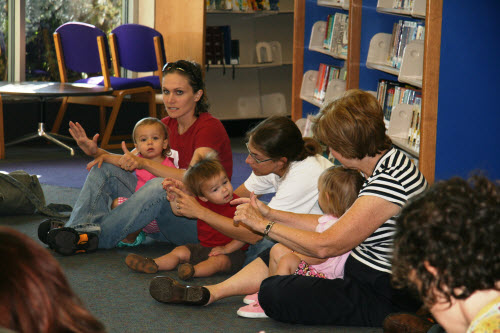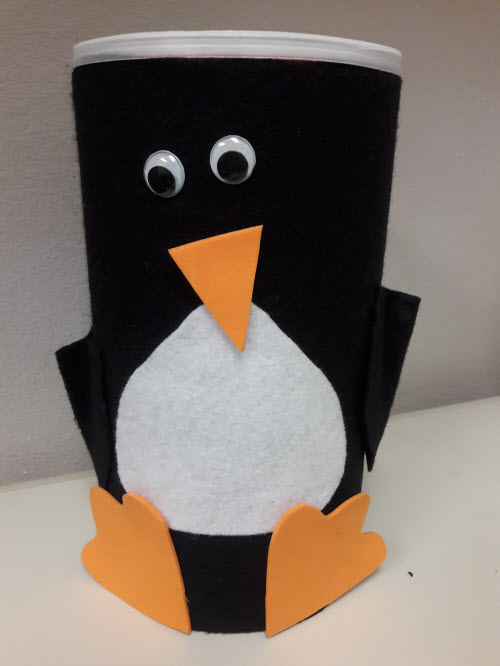Supercharging Your Storytime with Parent and Caregiver Tips
 Intentionally sharing tips with parents and caregivers at storytime can be a great way to expand learning from library to home. An early literacy tip, or an aside, is a couple of sentences (15-20 seconds) explaining the connection between the activity you are doing in storytime and literacy development. Many storytime practitioners find tips to be a challenging element to incorporate. “The hardest part was getting used to delivering an early literacy message in storytime. One of my co-workers actually ended up in tears! I've found that it can be challenging at first, but it's so important to learn how to do this,” said a participant in the Supercharged Storytimes Facilitator Training. Another participant referenced a colleague retiring early to avoid having to deliver early literacy tips!
Intentionally sharing tips with parents and caregivers at storytime can be a great way to expand learning from library to home. An early literacy tip, or an aside, is a couple of sentences (15-20 seconds) explaining the connection between the activity you are doing in storytime and literacy development. Many storytime practitioners find tips to be a challenging element to incorporate. “The hardest part was getting used to delivering an early literacy message in storytime. One of my co-workers actually ended up in tears! I've found that it can be challenging at first, but it's so important to learn how to do this,” said a participant in the Supercharged Storytimes Facilitator Training. Another participant referenced a colleague retiring early to avoid having to deliver early literacy tips!
Fear not! We think that the new Supercharged Storytimes self-paced course can offer some practical advice on how to painlessly work an early literacy tip for parents and caregivers into storytime. Library storytimes offer the rare opportunity to connect with children and adults at the same time. This means that storytime providers are well-positioned to make the connection between what we know about early literacy development and how adults can help boost that development during the rest of the day. Storytime providers can demonstrate, inspire, explain, and then empower parents and caregivers to try a behavior at home.
Even if children come to storytime, but go home to an environment that is not language rich or where these simple practices are not happening, the intervention of library storytime is not enough for those children to develop the skills they need, to arrive at school ready to learn to read. Library staff can help make those connections and inspire further early literacy activity at home.
In the Supercharged Storytimes course, Mari Nowitz, youth services librarian at Timberland Regional Library, shares this tip she uses at the end of storytime:
“I’m going to put out a bunch of blocks; grownups, as you are building with your child, you might want to talk about what you are building, the different shapes, how they are alike or different, what shapes you see. When you do those kinds of things, you are giving them connections that will help them later when they are trying to figure out what the letters are, how they sound, and identifying the shapes in letters. Playing with blocks can really help later when they are decoding letters and learning to read. Have fun playing with blocks today!”
And, Saroj Ghoting, early literacy consultant, offers this tip in the course:
“Phonological awareness is being able to hear the smaller sounds in words; when you sing, talk, read, and play around rhymes, you are helping develop phonological awareness which will later help children sound out the words when they learn to read.”
Many storytime practitioners have shared that they struggle with when to deliver the tip and are particularly concerned about interrupting the flow and/or losing the children’s attention. Saroj offers several suggestions for how to work it in smoothly, such as having a routine that includes tip-sharing so it is an expected part of storytime. Many additional ideas from Saroj and Mari are shared in the course.
Other practitioners note that they forget to share a tip, especially if they are already feeling shy or nervous. A few simple suggestions can remedy that, like writing the tip on a post-it note that is in the book you are reading. Mari shares the story of her supervisor who likes to script her parent tips in advance. That preparation eliminates the worry of nerves intervening. She crafted a darling penguin tip jar and puts her scripted tips in it;  parents enjoy her playful pun as she pulls out the tip of the day. It’s worked into her routine of storytime, so she will not get nervous and forget what to say, and it’s not intimidating coming from an adorable penguin jar. Practitioners offer many more clever ideas in the course.
parents enjoy her playful pun as she pulls out the tip of the day. It’s worked into her routine of storytime, so she will not get nervous and forget what to say, and it’s not intimidating coming from an adorable penguin jar. Practitioners offer many more clever ideas in the course.
When asked about delivering tips, the most common sentiment is feeling awkward and condescending. In the course discussion forum, storytime providers who are also parents emphasized, “It doesn’t feel teachery from the other side.” Mari often introduces her tips as “fun facts,” and one practitioner noted that “Even simply saying ‘fun fact’ could take the pressure off.” You can also preface your tip with “As you know…” which validates the adults. Everyone likes to know they are doing a good job. Included in the Supercharged Storytimes is a wonderful video where Mari describes her journey from feeling awkward and uncomfortable with this role to finding her voice and joyfully embracing it. It can be an incremental journey beginning with baby steps.
Storytimes are valuable in and of themselves, but to supercharge their value, we must help the adults continue to support early literacy at home. Visit the Supercharged Storytimes self-paced course to learn more about how to do this. There are six modules in the course, and Module 2 focuses on engaging parents and caregivers.
Photos: Rhythm Babies by Pioneer Library System on Flickr CC BY-NC-ND 2.0; and Tip Jar at Timberland Regional Library, used with permission.
This project is funded in part by OCLC and by the Institute of Museum and Library Services [grant number RE-95-17-0085-17].


